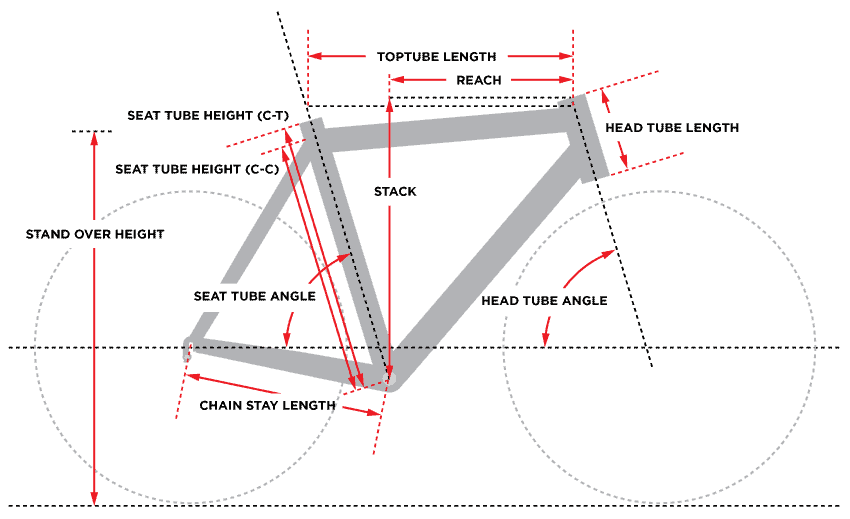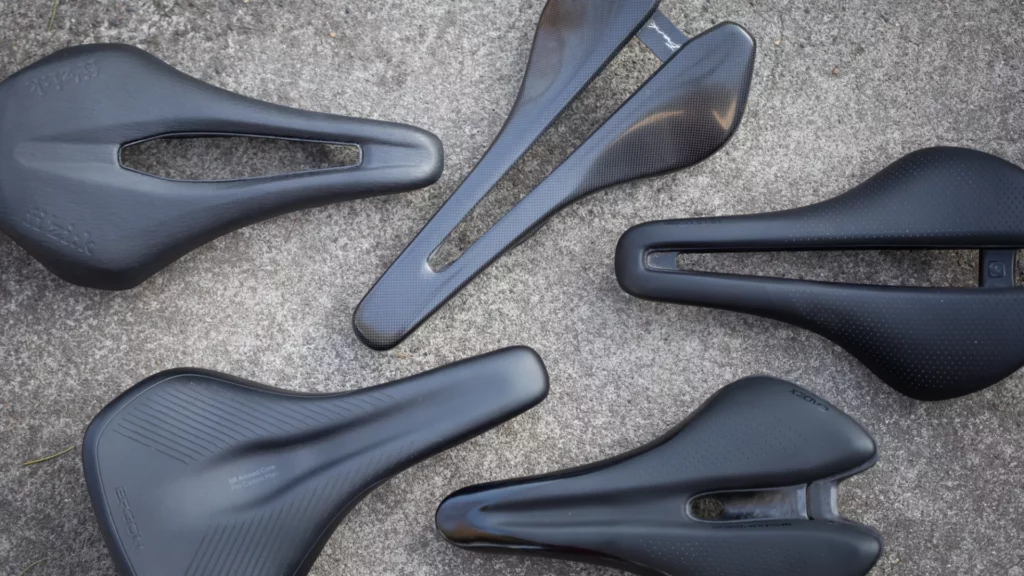When it comes to road bikes, one size certainly does not fit all.
Men and women have different body proportions and muscle mass, which means that a road bike for a male rider may be less comfortable and efficient for a female rider, and vice versa.
That’s why some bike brands offer road bikes for men and women, with differences in frame geometry, saddle shape, handlebar width and shape, crankarm length, and gear ratios.
I’ll discuss the key differences between men’s and women’s road bikes to help you understand how these differences can impact your riding experience.
Key takeaways
The table below summarizes the difference in characteristics and features between men’s and women’s road bikes.
| Comparison | Women’s road bikes | Men’s road bikes |
|---|---|---|
| Frame geometry | Shorter top tubes, head tubes, and steeper seat tube angles for a more upright position | Longer top tubes and head tubes for a more stretched-out, aerodynamic position |
| Saddle shape | Wider, shorter saddles with a cutout or depression to reduce pressure on soft tissue | Narrower, longer saddles for a more aerodynamic position and reduced thigh friction |
| Handlebar width and shape | Width: 36-40cm Shorter reach and shallower drop for more comfort | Width: 40-44cm Wider handlebars allow for a more stable, aggressive riding position |
| Crankarm length | Shorter crankarms (165-170mm) suitable for higher cadence and reducing knee and hip strain | Longer crankarms (170-175mm) provide more leverage and power |
| Gear ratios | Larger range of lower gears for less effort in climbing hills and challenging terrains. | Narrower range of higher gears for attaining faster speeds on flat/rolling terrains. |
Frame geometry

Frame geometry is the main difference between a men’s and women’s road bike.
Women’s road bikes tend to have shorter top tubes, shorter head tubes, and steeper seat tube angles. The main reason for these differences is that women typically have shorter torsos and arms relative to their leg length than men, so a bike frame that is too long can be uncomfortable and difficult to ride efficiently.
Shortening the top tube and head tube can help to create a more upright riding position that is comfortable for women with shorter torsos. Additionally, a steeper seat tube angle can position the saddle further forward, which is more comfortable and efficient for women’s shorter legs.
On the other hand, men’s road bikes tend to have longer top tubes and head tubes, which can help to create a more stretched-out, aerodynamic riding position. This can benefit male riders with longer torsos and arms relative to their leg length.
More reading : What Bike Size Am I?
Saddle shape

The shape of a saddle can significantly impact comfort and performance during long rides. By tailoring saddle shapes to the specific needs of men and women, bike manufacturers can help to ensure that their road bikes are suited for each rider’s unique anatomy and preferences.
Women’s road bikes often feature wider and shorter saddles. Women’s saddles may also have a cutout or a depression in the center to reduce pressure on soft tissue.
The wider and shorter shape of women’s saddles helps to distribute weight more evenly across the sit bones, reducing pressure and discomfort. The cutout or depression in the center can also help to reduce pressure on soft tissue and prevent numbness during long rides.
On the other hand, men’s saddles tend to be narrower and longer, which can help to provide a more aerodynamic riding position and reduce friction between the thighs during pedaling.
Handlebar width and shape

A common handlebar width for a women’s road bike is between 36 to 40cm and 40 to 44cm for a men’s road bike. Compact handlebars are popular nowadays because they have a shorter reach and shallower drop for a more comfortable position.
Women have narrower shoulders than men, so women’s road bikes often feature narrower handlebars. Women cyclists may also prefer handlebars with a shorter reach or a more ergonomic shape. Narrower handlebars can ensure the rider’s hands are positioned comfortably and efficiently on the handlebars, reducing fatigue and discomfort.
A shorter reach can also make it easier for women to reach the brake levers and shifters without stretching uncomfortably. Ergonomic handlebar shapes, such as those with a flared drop or a shallower drop, can also help to reduce strain on the wrists and hands.
In contrast, men’s road bikes may feature wider handlebars, allowing for a more stable, aggressive riding position.
More reading : How to Measure Handlebar Width
Crank length
Shorter crankarms can benefit cyclists who prefer to spin at a higher cadence. This is because they require less effort to pedal through a full revolution, allowing the rider to maintain a higher cadence without experiencing as much fatigue. Additionally, shorter crankarms can reduce strain on the knees and hips, making it easier to maintain a comfortable and efficient pedaling motion.
On the other hand, longer crankarms can provide more leverage and power, which can benefit cyclists prioritizing strength and power over speed and efficiency. However, longer crankarms can also make it more difficult to maintain a high cadence, as the extra length can make it more challenging to pedal through a full revolution.
Women tend to have shorter legs than men relative to their overall height, so women’s road bikes may feature shorter crankarms to accommodate this difference. Women’s road bikes generally come with 165, 167.5mm, or 170mm crankarm lengths, depending on the frame size. Men’s road bikes generally start from 170mm and go up to 175mm.
Gear ratios
Gear ratios in bicycles are crucial in facilitating a comfortable and efficient pedaling motion. In women’s road bikes, gear ratios are designed to accommodate the typically lower muscle mass and strength of female riders. By providing a broader range of lower gears, these bikes enable female cyclists to tackle hills and navigate challenging terrains with less exertion and fatigue.
Women’s road bikes often come with a compact crankset and smaller chainrings, enhancing the comfort and efficiency of the pedaling motion, regardless of their fitness level or cycling experience. This design proves especially advantageous for beginner female cyclists or those with less strength or experience than male cyclists.
Women’s road bikes typically feature smaller chainrings, such as 50/34T for Shimano or 46/33T for SRAM groupsets, coupled with larger cassettes, such as 11-34T for Shimano or 10-36T for SRAM. This combination results in a wider gear range, assisting in steep climbs and high-cadence pedaling.
Conversely, men’s road bike gear ratios balance power and speed, catering to male cyclists’ typically higher muscle mass and strength. Men’s road bikes can achieve higher speeds and maintain high power output levels on flat or undulating terrains by offering a narrower range of higher gears.
Men’s road bikes usually feature semi-compact (52/36T) or compact (50/34T) chainrings for Shimano, or 48/35T or 46/33T for SRAM groupsets, combined with smaller cassettes, such as 11-28T or 11-30T for Shimano and 10-33T or 10-36T for SRAM.
More reading : How Many Speed My Bike Has?
Women’s specific road bikes
Historically, several bike brands, including Specialized, Trek, and Canyon, offered women-specific road bike frames. However, in recent years, manufacturers have transitioned towards offering smaller-sized bikes, suitable for riders from 5’1” (155cm) up, instead of women-specific bikes. This shift enabled them to streamline their product range and simplify their offerings.
Presently, only a few brands offer women-specific road bike frames. Among them, the most notable are Liv and Scott.
- Liv, a sister brand of Giant Bikes, exclusively specializes in women’s-specific road bikes. Their product lineup includes models such as the Avail and Langma series, designed with women’s-specific frame geometry and components.
- Scott, another renowned bike manufacturer, offers women’s-specific road bikes like the Contessa and Addict models, tailoring their design to the needs of female riders.

Alex Lee is the founder and editor-at-large of Mr. Mamil. Coming from a professional engineering background, he breaks down technical cycling nuances into an easy-to-understand and digestible format here.
He has been riding road bikes actively for the past 12 years and started racing competitively in the senior category during the summer recently.